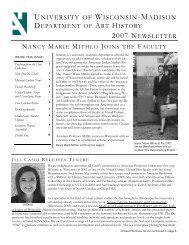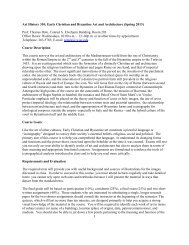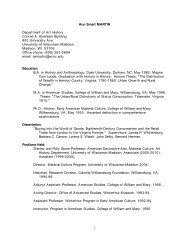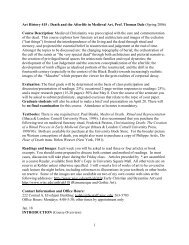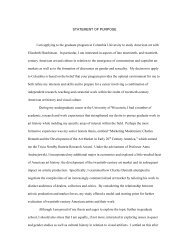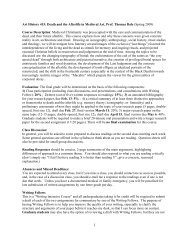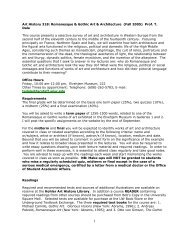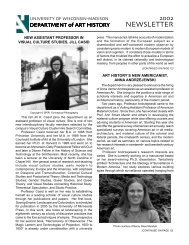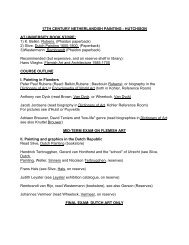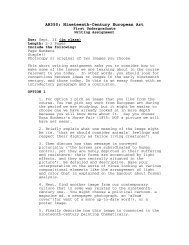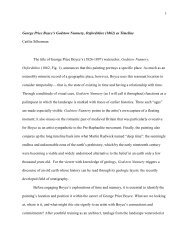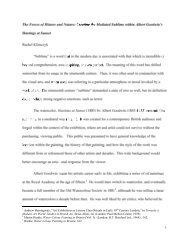University of Wisconsin-Madison Department of Art History
University of Wisconsin-Madison Department of Art History
University of Wisconsin-Madison Department of Art History
Create successful ePaper yourself
Turn your PDF publications into a flip-book with our unique Google optimized e-Paper software.
PAGE 10<br />
PAGE 3<br />
Alumni News<br />
Sarah Arnett (BA ‘05) works at Gladstone Gallery<br />
in Chelsea, New York City.<br />
After graduation, Lydia Barry Kutko (BA '05)<br />
moved to New York City with now-husband<br />
(Stefan Kutko, Engineering '05) to attend The<br />
Fashion Institute <strong>of</strong> Technology MA <strong>Art</strong> Market:<br />
Principles & Practices program. Lydia is<br />
currently a freelance writer in the arts; regular<br />
contributor (arts) to a small women's lifestyle<br />
magazine, and recently completed writing the <strong>Art</strong><br />
Style Guide, a pocket-sized manual <strong>of</strong> collecting<br />
art based upon defining one's own unique art<br />
style.<br />
Jane Bianco (MA’04) is currently curatorial<br />
assistant with the Farnsworth <strong>Art</strong> Museum in<br />
Rockland, Maine. This past year she has curated<br />
three print exhibitions featuring nineteenth and<br />
twentieth century works from the museum’s<br />
permanent collection, collaborated with the curator<br />
<strong>of</strong> historic properties on documentation and<br />
display <strong>of</strong> Victorian jewelry from the Farnsworth<br />
Homestead for a clothing exhibition (reviewed in<br />
a recent issue <strong>of</strong> Ornament Magazine); and with<br />
rug historian Mildred Cole Péladeau has curated<br />
and designed the exhibition Rug Hooking in<br />
Maine and Beyond, a display <strong>of</strong> historic Maine<br />
rugs from The Metropolitan Museum in New<br />
York, Maine institutions, and private collectors.<br />
In June, 2009 she presented research on the<br />
Maine-to-Massachusetts travels <strong>of</strong> polymath<br />
Jonathan Fisher (1768-1847) at the Dublin Seminar<br />
in Deerfield, Massachusetts, and continues to<br />
research his work and travels. She has recently<br />
been elected to the Maine Archives and Museums<br />
Board, and serves on its Communications Committee.<br />
Cynthia Becker (Ph.D. ‘00) was promoted to<br />
Associate Pr<strong>of</strong>essor <strong>of</strong> <strong>Art</strong> <strong>History</strong> at Boston<br />
<strong>University</strong> in 2009 and is currently pursuing<br />
research in Morocco with support from a Fulbright<br />
Hays grant.<br />
Rebecca Beverstein Wanek (BA ’01) is currently<br />
the Director <strong>of</strong> Development at the George<br />
Washington <strong>University</strong>'s School <strong>of</strong> Business in<br />
Washington, DC.<br />
Dee Boyle-Clapp (BS ‘83) is Program Coordinator<br />
and instructor for the <strong>Art</strong>s Extension Service,<br />
UMass Amherst, and teaches online courses for<br />
arts organization and museum administrators.<br />
Lynn T. Courtenay (Ph.D ’79). Lynn gave the<br />
inaugural address (en français) at an interdisciplinary<br />
conference on Marguerite <strong>of</strong> Burgundy<br />
held at the Maison Dieu in Tonnerre, Burgundy.<br />
Since then, the conference papers (and<br />
others) have appeared : Les établissements hospitaliers<br />
en France du Moyen Âge au XIXe siècle,<br />
directed by Sylvie Le Clech-Charton, (<strong>University</strong><br />
<strong>of</strong> Dijon, 2010). Also just launched is the English<br />
translation <strong>of</strong> Les charpentes du Xe au XIXe<br />
siècle, published with a new English-French<br />
glossary by Brepols (2010) as Ro<strong>of</strong> Frames from<br />
the 11th to the 19th century, ed. Patrick H<strong>of</strong>fsummer<br />
on which Courtenay worked with an international<br />
team if specialists. Numerous articles in the<br />
Oxford Dictionary <strong>of</strong> the Middle Ages (OUP,<br />
2010).<br />
Louisa Brouwer (BA ‘09) is currently completing<br />
the second year <strong>of</strong> the Winterthur Program in<br />
American Material Culture. Her master's thesis,<br />
primarily based in England, will look at the transnational<br />
trade <strong>of</strong> jewelry between England and America<br />
in the 18th century.<br />
Robert Cozzolino (MA ‘00, PhD ‘06) is Curator <strong>of</strong><br />
Modern <strong>Art</strong> at the Pennsylvania Academy <strong>of</strong> the<br />
Fine <strong>Art</strong>s in Philadelphia. He is organizing a retrospective<br />
<strong>of</strong> Peter Blume (1906-1992) and an exhibition<br />
<strong>of</strong> artists’ portraits and self-portraits drawn<br />
largely from PAFA’s collection. His essay “Henry<br />
Koerner, Honoré Sharrer and the Subversion <strong>of</strong><br />
Reality: ‘Magic Realism’ and the Photograph,” will<br />
appear in Shared Intelligence: American Painting<br />
and the Photograph, ed. B. Buhler Lynes and J.<br />
Weinberg (<strong>University</strong> <strong>of</strong> California Press, 2010). He<br />
is also contributing an essay to PAFA’s upcoming<br />
Henry O. Tanner exhibition catalogue. In addition to<br />
his museum activities he presented papers at the<br />
conference “Belief and Disbelief in the Space Between,<br />
1914-1945” at the <strong>University</strong> <strong>of</strong> Portland, OR<br />
this past June and last year spoke in the Terra Foundation<br />
for American <strong>Art</strong>'s symposium, “What’s<br />
Modern About American <strong>Art</strong>?” He has also written<br />
for www.artjaw.com, a Philadelphia-based writing<br />
project about working in the art world.<br />
Linde Brady (MA ‘05) will be the sole juror for<br />
"Image Ohio 2011", a statewide exhibition focusing<br />
on photographers and video artists, in association<br />
with the Roy G Biv Gallery in Columbus, Ohio.<br />
The works will be exhibited in early 2011 at the<br />
Shot Tower Gallery on the campus <strong>of</strong> Fort Hayes as<br />
a satellite exhibition <strong>of</strong> Roy G Biv Gallery.<br />
John Forbes (BA ’67) is currently cataloger at<br />
Regenstein Library <strong>University</strong> <strong>of</strong> Chicago.<br />
Vivien Green Fryd (PhD ‘84) is chair <strong>of</strong> the <strong>History</strong><br />
<strong>of</strong> <strong>Art</strong> <strong>Department</strong> at Vanderbilt <strong>University</strong>.<br />
Most recent publications include: “Lifting the Veil<br />
<strong>of</strong> Race at the U.S. Capitol: Thomas Crawford’s<br />
Statue <strong>of</strong> Freedom,” COMMON-PLACE, 10, no. 4<br />
(2010) and “Bearing Witness to the Trauma <strong>of</strong> Slavery<br />
in Kara Walker’s Videos:Testimony, Eight Possible<br />
Beginnings, and I was Transported.” Continuum:<br />
Journal <strong>of</strong> Media & Cultural Studies, 24, no. 1<br />
(2010): 145-59.<br />
Laura Furney (MA ‘93) is Managing Editor <strong>of</strong> the<br />
<strong>University</strong> Press <strong>of</strong> Colorado in Boulder.<br />
Daryl Haessig (MA '03) is currently the Associate<br />
Director <strong>of</strong> Lakeland College's <strong>Madison</strong> Center,<br />
advising adult undergraduate students and teaching<br />
<strong>Art</strong> <strong>History</strong> II (Renaissance to Contemporary).<br />
Arielle Hambrecht (BS ‘06) received an MA in the<br />
Humanities from the <strong>University</strong> <strong>of</strong> Chicago in 2007<br />
before moving to San Francisco where she works for<br />
the Fine <strong>Art</strong>s Museums <strong>of</strong> San Francisco in the<br />
Objects Conservation <strong>Department</strong> at the de Young<br />
Museum.<br />
Cynthia Hammett (BA '64, MA '66) is one <strong>of</strong> three<br />
painters exhibiting at Fort Worth Community Center<br />
<strong>of</strong> the <strong>Art</strong>s. WE3: West to East; April 2010.<br />
Erin Hanke (BS ‘04) is a merit scholarship recipient<br />
and MA candidate at Mannes College <strong>of</strong> Music<br />
in New York City. She received a teaching assistantship<br />
at the Eugene Lang College <strong>of</strong> Liberal <strong>Art</strong>s<br />
for Spring 2011. This past summer she participated<br />
in the 33rd Ringve International Summer Course<br />
held at Sund Folkehøyskole and the St. Olav<br />
Festival in Inderøy, Norway.<br />
Tasha (Hillen) Ford (BA '05) recently married<br />
(March 2010) and has relocated to Orlando, FL.<br />
Meghan Meulemans (BS ’06) completed a<br />
certificate <strong>of</strong> Historic Preservation at the <strong>University</strong><br />
<strong>of</strong> Washington in Seattle and will be<br />
finishing the Master <strong>of</strong> Science in Architecture<br />
<strong>History</strong>/Theory degree program this fall. Her<br />
thesis investigates the role <strong>of</strong> women as designers,<br />
clients, and promoters <strong>of</strong> modern architecture<br />
in interwar France. Meghan volunteers at<br />
Historic Seattle, where she has helped to nominate<br />
a 1915 bungalow as a City <strong>of</strong> Seattle Landmark<br />
and works on other historic preservation<br />
projects.<br />
Kim Miller (MA ’95) received tenure, and was<br />
promoted to Associate Pr<strong>of</strong>essor <strong>of</strong> <strong>Art</strong> <strong>History</strong><br />
and Women's Studies at Wheaton College<br />
(Norton, MA). She also received a National<br />
Endowment <strong>of</strong> the Humanities Fellowship for<br />
<strong>University</strong> and College Teachers for her book<br />
manuscript, "Selective Silencing and the Shaping<br />
<strong>of</strong> Memory in Post-Apartheid South African<br />
Visual Culture". Miller also received the 2010<br />
Carrie Chapman Catt Prize for Research on<br />
Women and Politics, and is the first art historian<br />
ever to win that award.<br />
Joann Moser (PhD ’76) is Senior Curator at the<br />
Smithsonian American <strong>Art</strong> Museum. Two<br />
recent publications include: “Digital Déja Vu,”<br />
in Printed on Paper: The Techniques, <strong>History</strong><br />
and Conservation <strong>of</strong> Printed Media, ed. Jane<br />
Colbourne and Reba Fishman Snyder,<br />
(Newcastle upon Tyne UK, 2009), 177-184 and<br />
What’s It All Mean: William T. Wiley in Retrospect<br />
(Berkeley, CA /Washington D.C., 2009).<br />
Nora Nett (BA ’02) is Vice President <strong>of</strong> Physical<br />
Production at Endgame Entertainment, and<br />
recently oversaw production <strong>of</strong> the Nicolas<br />
Cage suspense thriller titled "The Hungry Rabbit<br />
Jumps", due out in 2011. Nora will oversee<br />
the Joseph Gordon Levitt & Bruce Willis sci-fi<br />
feature "Looper" by writer/director Rian Johnson<br />
this fall in New Orleans.<br />
Abayomi Ola (MA ‘05) received his PhD (May<br />
2009) in art history from the <strong>University</strong> <strong>of</strong> Iowa,<br />
Iowa City. He starts the second year <strong>of</strong> a fulltime<br />
tenure track position as assistant pr<strong>of</strong>essor<br />
<strong>of</strong> art history at Spelman College, Atlanta, GA,<br />
in the fall semester.<br />
As the Outreach Specialist for the statewide<br />
digitization program <strong>Wisconsin</strong> Heritage<br />
Online, Emily Pfotenhauer (BA ‘02) provides<br />
training and support to <strong>Wisconsin</strong> libraries,<br />
archives, museums and historical societies planning<br />
digitization projects. She continues to build<br />
the <strong>Wisconsin</strong> Decorative <strong>Art</strong>s Database (http://<br />
content.wisconsinhistory.org/decorativearts),<br />
which now features more than 1,000 artifacts<br />
from the collections <strong>of</strong> over 40 museums and<br />
historical societies throughout the state.<br />
Kelsey Pieper (BS '08) will be beginning the<br />
MA program in <strong>Art</strong> <strong>History</strong> - Modern/<br />
Contemporary <strong>Art</strong> at George Washington <strong>University</strong><br />
in fall 2010.<br />
<strong>Art</strong> <strong>History</strong> Majors honored by<br />
Phi Beta Kappa Society<br />
We are pleased to congratulate eight <strong>Art</strong> <strong>History</strong> majors who have<br />
been honored by The Phi Beta Kappa Society: Elizabeth Ellison<br />
Books, Adrienne Rene Bullis, Alexandra Ileana Demet, Ana<br />
Maria Devcic, Treena Nicole Fischer, Mia Lucille Forslund, Sarah<br />
Louise Gill, and Andrew Kevin Scott. Phi Beta Kappa, the nation’s<br />
oldest and best known academic honor society, was founded at the<br />
College <strong>of</strong> William and Mary in 1776. Only the top 10% <strong>of</strong> seniors are<br />
considered for the honor. Here, in their own words, are the stories <strong>of</strong><br />
some <strong>of</strong> these students, their scholarly interests and what they have<br />
gained from their experiences as art history majors.<br />
Ana Maria Dvecic: “I am particularly interested in contemporary art<br />
because its possibilities are endless and there is always<br />
something new to learn and discover. I have really enjoyed<br />
my experience at the <strong>University</strong> <strong>of</strong> <strong>Wisconsin</strong> and I<br />
am really glad I chose <strong>Art</strong> <strong>History</strong> as my major. I have<br />
had the opportunity to explore a wide-range <strong>of</strong> topics and<br />
develop new ways <strong>of</strong> analyzing art, history, and culture<br />
on a daily basis. The enthusiasm <strong>of</strong> my pr<strong>of</strong>essors<br />
throughout these years has been inspirational. Their support<br />
and encouragement has helped me develop a confidence<br />
in my abilities and an appreciation for the subject<br />
that I will carry with me throughout my life.”<br />
Alexandra Demet: “My interest in art history began as a mere curiosity:<br />
Two years ago I saw that Pr<strong>of</strong>. Jill Casid was teaching a course on<br />
word-image theory, which I thought might be germane to my work in<br />
literary studies. That was the start <strong>of</strong> my work in art history, which now<br />
encompasses a broad range <strong>of</strong> theoretical approaches to visual culture<br />
from the early modern period to contemporary. I'm currently putting<br />
together a long-term project (under the guidance <strong>of</strong> Pr<strong>of</strong>. Casid) on<br />
psychoanalytic theory and the vexed subject <strong>of</strong> hysteria—namely, the<br />
development and deployment <strong>of</strong> representations <strong>of</strong> the hysteric body in<br />
art and visual culture, primarily during the nineteenth century and on to<br />
rise <strong>of</strong> artistic and literary modernism in the early twentieth century.<br />
This forms the nexus from which I will be exploring a number <strong>of</strong> interrelated<br />
questions about subjectivity, agency, power relations, gender<br />
and sexed embodiment.”<br />
Henry John Drewal continued...<br />
in the Yoruba Universe (1998), shown at<br />
UCLA’s Fowler Museum and UW’s<br />
(then) Elvehjem Museum; Mami Wata:<br />
<strong>Art</strong>s for Water Spirits in Africa and its<br />
Diasporas (2008-09), shown at the<br />
Fowler Museum, UW’s Chazen Museum<br />
and at the National Museum <strong>of</strong> African<br />
<strong>Art</strong> <strong>of</strong> the Smithsonian Institution, Washington,<br />
D. C. (where it received rave<br />
reviews in the New York Times and<br />
Washington Post); and two smaller traveling<br />
exhibitions, Joyful Blues: Yoruba<br />
Indigo Dyed Textile <strong>Art</strong>s (Adire) and<br />
Patchwork Quilts <strong>of</strong> the Africans (Siddis)<br />
<strong>of</strong> India.<br />
The third area <strong>of</strong> innovation in<br />
Drewal’s scholarship relates most closely<br />
to his research project for the IRH. While<br />
there is a natural tendency for art historians<br />
to emphasize the visual, recent<br />
research on many different cultures has<br />
called attention to the multi-sensorial environment<br />
in which art and material culture<br />
operate. Informed by both current artistic<br />
practice and his study <strong>of</strong> the multimedia<br />
spectacles <strong>of</strong> the Yoruba cultures, Drewal<br />
advocates a “sensorially engaged” scholarship<br />
that recognizes in “art” the primacy <strong>of</strong><br />
sensual understanding over the written<br />
word. He aims to explore how African<br />
artists as well as their audiences use the<br />
traditional five senses (sight, taste, hearing,<br />
speaking, touch) as well as motion<br />
and extra-sensory perception to “create<br />
and respond to the affective and aesthetic<br />
qualities <strong>of</strong> art.” He goes beyond the arguments<br />
<strong>of</strong> phenomenology to place particular<br />
emphasis on the kinetic aspect (his<br />
sixth sense) and on extra-sensory perception<br />
or intuitions, which he relates to<br />
synaesthesia. Drewal has already begun<br />
Mia Forslund: “I am currently concerned with interrogating issues<br />
<strong>of</strong> gender equality and difference both in the early modern period<br />
as well as in more contemporary art movements. Though I did not<br />
begin my academic career at the university knowing I would pursue<br />
a degree in art history, I am so glad I discovered all that the<br />
program has to <strong>of</strong>fer. From my experience as an art history major, I<br />
have gained a greater appreciation for the many works <strong>of</strong> art I have<br />
so long admired, through in-depth study <strong>of</strong> the social and historical<br />
contexts in which they were produced. Additionally, the art history<br />
courses I have taken have helped me to develop my critical reading<br />
and interpretation skills, which have benefited me both in my academic<br />
studies and in other areas <strong>of</strong> my life. I hope to continue my<br />
studies within the field <strong>of</strong> art history after completing my undergraduate<br />
degree.”<br />
Sarah Gill: “After studying abroad in Florence, Italy my<br />
Junior year, I developed a passion for Renaissance art. I<br />
found that being surrounded by the art I was studying was<br />
very different than seeing an image on a screen, and I was<br />
able to be much more engaged with the art. I was able to<br />
revisit paintings and sculptures that were not fresh in my<br />
mind and get a better feel <strong>of</strong> the little nuances that unfortunately<br />
slides <strong>of</strong>ten cannot show. Also being able to be<br />
apart <strong>of</strong> the culture that surrounds the art <strong>of</strong>fers a very<br />
different environment for viewing art. I have really enjoyed<br />
my four years studying art history at UW-<strong>Madison</strong>. I found<br />
that the pr<strong>of</strong>essors were approachable and extremely willing to<br />
help with any additional information that was not covered in class.<br />
While I was also thinking about applying to graduate schools<br />
abroad many <strong>of</strong> the faculty were able to <strong>of</strong>fer me advice and helpful<br />
suggestions which I appreciated.”<br />
Andrew Scott: “Although I enjoy all types <strong>of</strong> artwork, I have concentrated<br />
mostly on that which was produced during the Italian<br />
Renaissance. Pr<strong>of</strong>. Geiger has challenged me to look closely at how<br />
artists <strong>of</strong> that period interacted with a variety <strong>of</strong> social, political,<br />
and economic circumstances. As a result, I have gained a better<br />
understanding <strong>of</strong> the peoples and places <strong>of</strong> Early Modern Europe. I<br />
would not be in the position I am today without the skills I have<br />
learned as an <strong>Art</strong> history major. My studies have encouraged me to<br />
look at the world with an analytical eye, while simultaneously enhancing<br />
my appreciation for the beauty <strong>of</strong> human creativity.”<br />
this project with support from two prestigious<br />
fellowships this year, a senior fellowship<br />
at the Sainsbury Research Unit <strong>of</strong> the<br />
<strong>University</strong> <strong>of</strong> East Anglia in Norwich<br />
(UK) in the Spring semester, and a fellowship<br />
at the National Museum <strong>of</strong> African<br />
<strong>Art</strong>-Smithsonian Institution in Washington,<br />
D. C. this summer.<br />
His research on art and the senses has<br />
already been a part <strong>of</strong> his teaching at UW<br />
and will be enhanced in the future. For<br />
example, he has taught seminars on<br />
"African Masking and the Senses" and this<br />
fall he will teach a museum studies seminar<br />
that will focus on multi-sensorial and<br />
interactive ways <strong>of</strong> displaying African art<br />
for the new permanent gallery that will be<br />
part <strong>of</strong> the new Chazen Museum expansion<br />
scheduled to open in October 2011.



